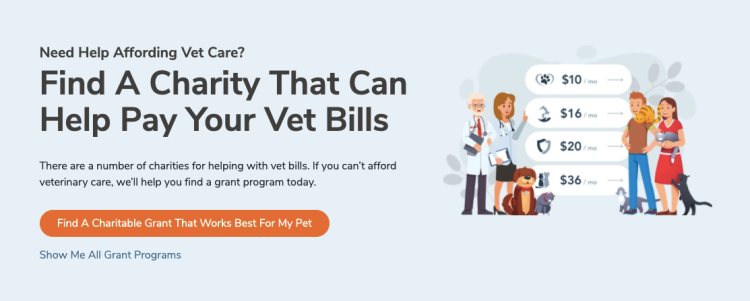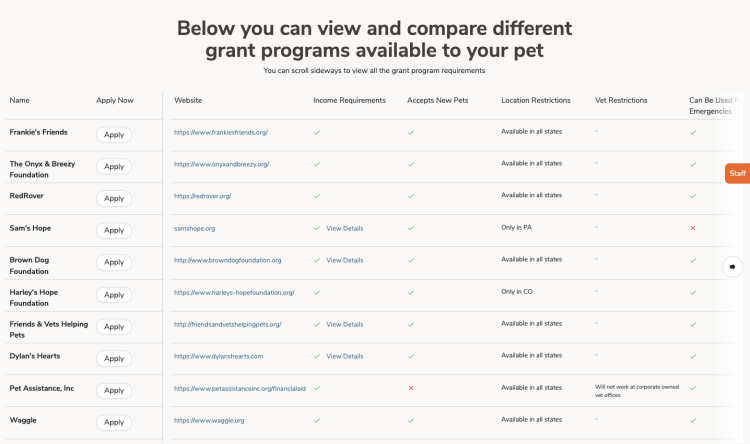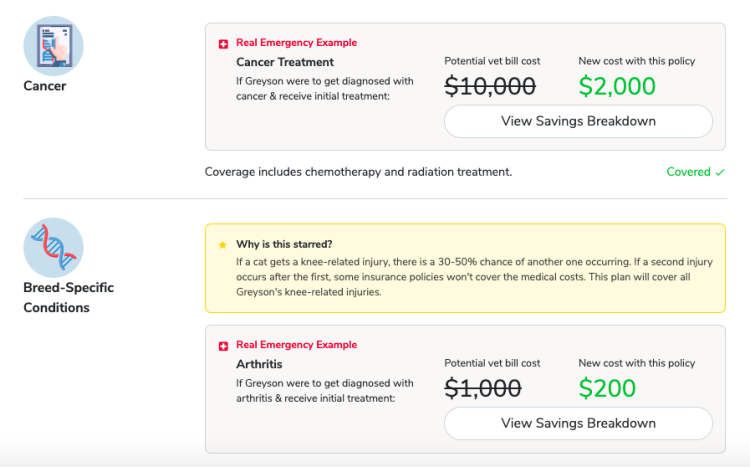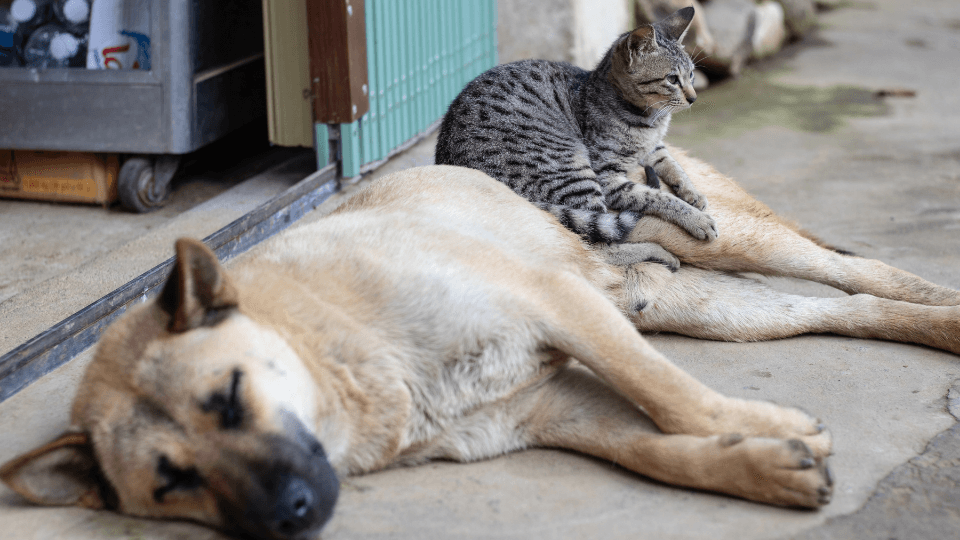When you fall in love with a dog or cat at the adoption center, the last thing you want to think about is finding affordable pet care. But determining how you’ll pay for your pet’s medical expenses is an important thing to consider before you become a new pet owner. This is true not only for your wallet but also for your pet.
Veterinary care can get expensive, especially without pet insurance. According to our research on veterinary costs, a routine checkup can cost as much as $250 while emergency surgery can cost as much as $5,000. We owe it to our pets to give them the best medical care possible, so we must consider how we’ll pay for their care when they need it most.
Thankfully, you can get your pet the care they need on almost any budget, and there are plenty of options if you can’t afford to pay your vet bill. Here, we’ll explore what low-cost alternatives are available, how you can find financial assistance programs, and how pet insurance can help you save money and pay for your pet’s veterinary care.
Where to Find Low-Cost Alternative Pet Care
Plenty of organizations provide care or other types of direct assistance to pet parents. Their overall goal is keeping pets healthy and at home with their families. If you have a humane society nearby, they may be a good place to start.
Here are some of the most common services available to pet parents and where you might find them.
Pet food and other pet products
If you’re having trouble keeping your pet fed, one of the first things you can do is check to see if there is a pet food bank in your area. Some pet shelters provide pet food to needy families. Some animal welfare organizations run pet food banks specifically to help pet parents in need.
If you’re having trouble finding locations that provide help, this interactive map shows you where to find food and supply distribution centers, shelters, and other resources.
 (Source: Feeding Pets of the Homeless)
(Source: Feeding Pets of the Homeless)
There may be a pet shop in your area that provides food and supplies to those in need. You can also ask regular food banks in your area if they carry pet food. Try searching online, calling local food banks, or contacting your local humane society to find out if there are locations near you.
Spay and neuter services
Most shelters and rescue organizations spay or neuter animals before they put them up for adoption. Still, it isn’t unheard of for a pet parent to suddenly find themselves with a pet that hasn’t been spayed or neutered. For example, if one of your pets unexpectedly gives birth, you may have an entire litter of animals that need these services.
Luckily, several organizations provide free or low-cost spay and neuter services.
For example, the ASPCA offers low-cost spay & neuter programs in New York City, Los Angeles, and Ashville, North Carolina. Your state or local humane society may offer its own spay and neuter services at low costs.
Many veterinary clinics also offer discounted spay and neuter services. You can use PetSmart Charities' spay/neuter clinic map to find a neuter clinic in your area, or simply call your veterinarian and ask.
 (Source: PetSmart Charities
(Source: PetSmart Charities
Some organizations even operate mobile spay and neuter clinics in certain locations.
Finally, check with your state to determine if they provide any grants or vouchers for spay and neuter services. For example, if you live in Massachusetts, you may qualify for free spay and neuter vouchers if you’re already enrolled in some government assistance programs or you need to apply for financial assistance.
Some state assistance programs may help if you have a service or companion animal.
Discounted veterinary care services
In addition to spay and neuter services, many animal welfare organizations, rescue groups, and shelters offer low-cost vet care assistance. They may not do expensive surgeries at a discount, but you can often get your pet vaccinations and even some types of routine and preventative care at an affordable price.
If your pet needs a procedure you can’t afford, try your local veterinary medicine school. Many veterinary colleges have programs that help students get hands-on experience with animals in need of care (under the supervision of a licensed vet).
Start with the AVMA's list of accredited veterinary colleges and see if there is a program near you.
Finally, if you’re a client in good standing, work directly with your veterinarian or animal hospital to manage your costs. Some vets offer payment plans that can make expensive care more attainable for low income pet owners. If you’re a pet parent on a budget, ask for a second opinion from another vet to see if there are more affordable treatments available.
Finding Financial Assistance Programs for Pet Care
In addition to low-cost supplies and care, you can also seek financial assistance to pay your veterinary bills. You don’t have to scour the internet in search of help, either. We’ve created an app for that, so you can find a charity that can help pay your vet bills right now.

After filling our a short form, you'll see chratity grant programs you're eligible for.

Most financial assistance programs are run by nonprofits. They may only operate at the state level or within their local communities.
You usually need to apply to get help from nonprofits and other financial assistance organizations. In most cases, you can apply online or call an office line to start the process.
Keep in mind that you may need to produce financial information, such as a tax return, to prove you are in need.
Nationwide financial assistance programs for pet care
If you can’t find any local financial assistance for you and your pet, you can broaden the scope of your search. Some rescue organizations and animal protection groups will assist if a dog or cat is in dire need, wherever they are.
Several national organizations provide financial assistance to pet owners. Here are a few you should be aware of:
- The American Veterinary Medical Foundation (AVMF) Charitable Fund
- The Bow Wow Buddies Foundation
- The National Frankie's Friends Fund
- The Handicapped Pets Foundation (Wheelchairs for Handicapped Pets)
- The Joshua Luis Animal Cancer Foundation (Cancer-specific)
- The Magic Bullet Fund (Cancer-specific)
- The Mosby Foundation
- Pets of the Homeless
- The Riedel and Cody Fund
- Red Rover Relief
- Waggle (Crowdfunding)
This isn’t an exhaustive list of national financial assistance options. Speak with your veterinarian or your local animal shelter to find if there are any other options available to you. And don’t forget to try out our pet charity search tool!
How Pet Insurance Can Save You Money on Pet Care
If you’re concerned that you won’t be able to pay for your pet veterinary costs, pet insurance can be a lifesaver. Pet insurance does require you to pay a monthly premium, but there are numerous benefits to getting your pet covered.
First off, it isn’t just a smart investment for your budget — it can also ensure your pet always has access to care.
Pet insurance gives you access to a high standard of care regardless of how much money you have in your bank account. Even if you must pay a significant vet bill, you can rest assured that your pet insurance will reimburse you for a significant amount of the cost.
That means your furry friend will always get the pet care they deserve, no matter your financial situation.
Buying pet insurance is also an ideal way to hedge against risk. There’s no way we can predict when our pets will get sick or injured, and their care needs don’t always coincide with the funds we have on hand. Just as you insure your vehicle to address the risk of an accident, it makes sense to insure your pet to address the risk that they’ll become ill.
What’s covered under pet insurance?
Most pet insurance plans are known as “accident and illness” plans. That means they cover unexpected veterinary costs associated with the treatment of pet illnesses and physical accidents.
For example, if your pet breaks their leg or comes down with an ear infection, they’ll likely be covered by a pet insurance plan.
Pet insurance also covers emergency vet costs and life-saving care. In the event of a serious emergency that requires expensive treatment, you won’t have to worry about being stuck with a pet care bill that costs thousands of dollars. Your pet insurance can reimburse you for most of the expenses, so you’ll only have to cover a fraction of it.
Similarly, your accident and illness plan may cover some of the costs if your pet is admitted to an animal hospital. These costs can add up, but your pet insurance plan could pay for itself almost instantly — and then some — with the savings it will provide you.
What’s covered under a wellness plan?
If you want to cover routine care, you should shop for wellness plans alongside standard pet insurance. These plans cover routine veterinary services like office visits, exams, rabies vaccines, routine bloodwork, fecal tests, and even heartworm prevention treatments, in some cases.
Most pet insurance companies offer a wellness plan as an “add-on” feature. That means you buy them alongside your regular pet insurance plan. Wellness plans are generally affordable, and they can be a huge help in paying your regular veterinary costs.
You can also get a wellness plan as a stand-alone product from some companies. For example, Wagmo offers a pet wellness plan as its core product. You can buy a wellness plan from them without having to sign up for regular pet insurance.
How pet insurance pays for veterinary costs
Pet insurance works a little differently than human health insurance. Instead of covering costs when it comes time to pay your vet, clinic, or animal hospital, pet insurance reimburses you for a percentage (up to 90%) of the costs you’ve already paid.
That means you do have to cover your vet bills when they come due. But you can do so knowing that you’ll be reimbursed for a significant portion of the costs later. Many pet parents keep a specific card or account to pay for veterinary expenses, then deposit the money when their reimbursements come through.
The most important thing to understand is that the amount of money you’ll save in the end is well worth the cost of your insurance premiums.

Consider the Pets Best plan listed above. If your pet insurance plan covers 80% of a $3,000 vet bill and you’ve already hit your $500 yearly deductible, you can get reimbursed by $2,400 to treat your cat or dog.
That means you only end up paying $600 to the clinic. And because you’re only paying $44.20 per month for the plan, it’s already paid for itself several times over in savings.
Here's some real-world examples:

Find Affordable Pet Care with Pawlicy Advisor
Above, we listed several tools and resources you can use to find low-cost veterinary care and assistance. To recap, here are some of the best tools for finding affordable pet care:
- Find pet food and supplies
- Find spay and neuter clinics
- Find low-cost veterinary care from accredited vet schools
- Find charitable grant programs you might be eligible for
- Find the best pet insurance provider for you breed
If you’re looking for help finding financial assistance, look no further than Pawlicy Advisor :)
Again, our new app can find a charity to help pay your vet bills. Just answer some basic questions about your pet and our algorithm will find a charity or grant program that can help. You can also browse our entire list of programs.
And, we make it easier than ever to find a pet insurance plan that fits your budget and your pet’s needs, too. Our savings algorithm will provide you with some top recommendations based on your budget needs, and you can select the plan that makes sense for your wallet.
